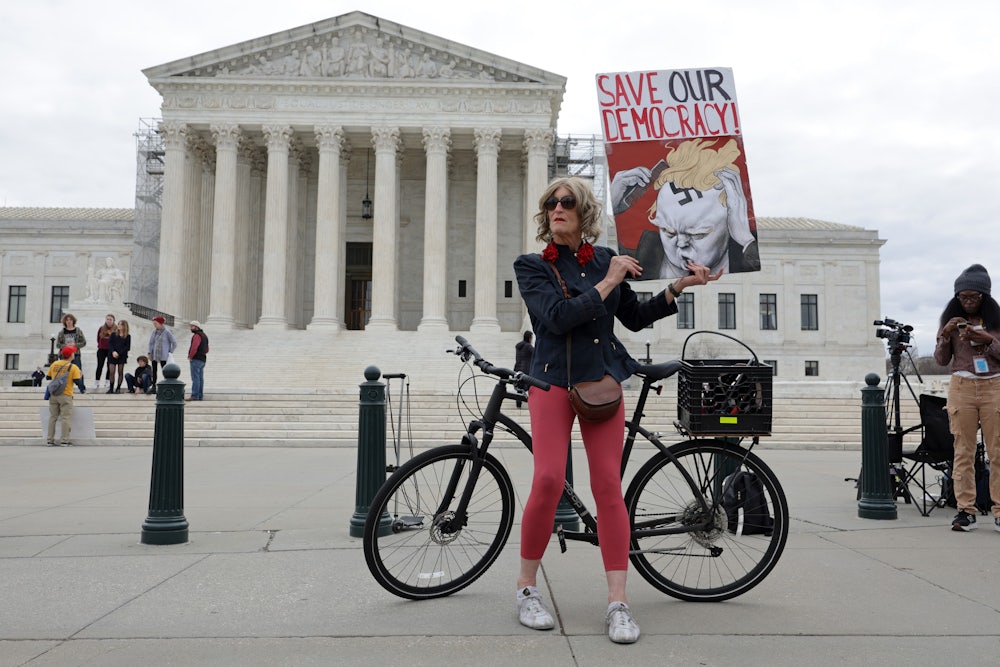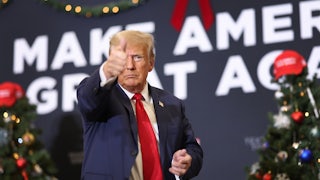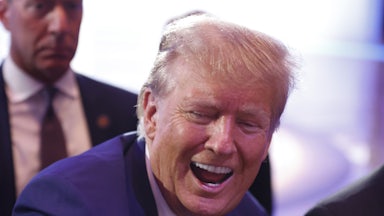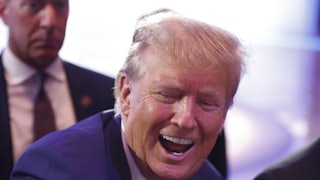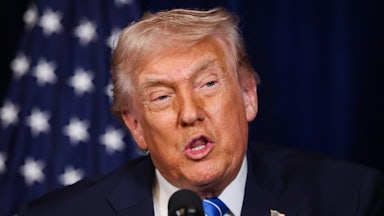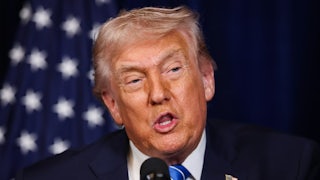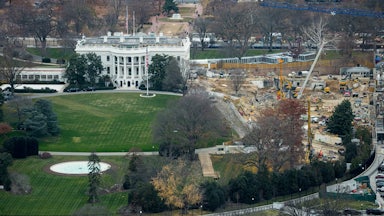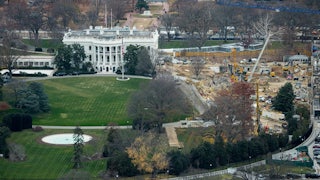The Supreme Court’s ruling in Trump v. Anderson is a disaster for the American constitutional order. It paves the way for insurrectionists to run for and hold federal office despite the Constitution’s categorical language that disqualifies them. It decides questions that weren’t before the justices in this case in the first place, and the answers they gave will only immunize these and future insurrectionists from potential consequences. It blatantly twists text and history to reach a preferred outcome. In a case about the importance of oaths of office, the justices seem to have forgotten theirs.
In their central holding on Monday, the justices unanimously overturned a Colorado Supreme Court ruling that former President Donald Trump was barred from the ballot by the Fourteenth Amendment’s disqualification clause. That clause bars former officeholders who participated in “insurrection or rebellion” from holding future public office. To overturn that ruling, the justices held that the states can’t enforce the clause against federal officeholders.
Then the court’s five male conservative justices went even further to insulate Trump from the clause’s language. They held that federal candidates and officeholders can only be disqualified if Congress passes a law to affirmatively enforce the clause. That would appear to forestall disqualification by other means—if, for example, a Democratic-led Congress refuses to count Trump’s electoral votes next January because he is disqualified.
The other four justices parted ways with their colleagues on this part. Justice Amy Coney Barrett, writing only for herself, pointedly argued that the case “does not require us to address the complicated question whether federal legislation is the exclusive vehicle through which Section 3 can be enforced.” The court’s three liberal justices went even further to directly castigate the five justices in the majority for their overreach.
“Although federal enforcement of Section 3 is in no way at issue, the majority announces novel rules for how that enforcement must operate,” Justices Sonia Sotomayor, Elena Kagan, and Ketanji Brown Jackson wrote in their joint concurring opinion. “It reaches out to decide Section 3 questions not before us, and to foreclose future efforts to disqualify a Presidential candidate under that provision. In a sensitive case crying out for judicial restraint, it abandons that course.”
To understand why Monday’s ruling is so calamitous, one must start with the text of the disqualification clause itself. That clause, which is found in Section 3 of the Fourteenth Amendment, reads as follows:
No person shall be a Senator or Representative in Congress, or elector of President and Vice-President, or hold any office, civil or military, under the United States, or under any State, who, having previously taken an oath, as a member of Congress, or as an officer of the United States, or as a member of any State legislature, or as an executive or judicial officer of any State, to support the Constitution of the United States, shall have engaged in insurrection or rebellion against the same, or given aid or comfort to the enemies thereof. But Congress may by a vote of two-thirds of each House, remove such disability.
This clause’s language is thunderous and unequivocal. It is, I admit, somewhat awkwardly written: The drafters made it hard to casually parse by explicitly naming so many offices to which it applies. But the thrust of the amendment is clear. In general terms, no person who previously swore an oath to the United States and then “engaged in insurrection or rebellion” against it can ever again hold another public office at the state or federal level. Only the overwhelming judgment of Congress can remove that disqualification once it attaches.
While the clause excluded numerous ex-Confederates after the Civil War, Congress ultimately waived it for most of them in 1873. The disqualification clause then lapsed into irrelevance for the next century and a half—not because it was no longer operative but because the U.S. did not experience another insurrection or rebellion during that time. Only after January 6 did it become relevant once more. William Baude and Michael Stokes Paulsen, two prominent conservative legal scholars, argued last year in an influential law review article that the disqualification clause still carried legal weight. Their originalist analysis led them to conclude that the clause was still active, that it was self-executing, and that it applied to Trump and his co-conspirators.
Buoyed by that argument and others, a group of voters sued Colorado Secretary of State Jenna Griswold last year to challenge Trump’s inclusion on the 2024 primary ballot. They argued that he was automatically disqualified from future office for his role in orchestrating the events of January 6 while serving as president. The Colorado Supreme Court agreed with that argument last December and ordered Trump removed from the ballot. (They stayed their ruling pending appeal, so Trump’s name is still technically on the state ballot when Colorado voters take part in Super Tuesday this week.)
It was clear at oral argument last month that the justices, for whatever reason, did not want to enforce the disqualification clause against Trump. What they struggled to articulate during that session was a reason why it shouldn’t be enforced against him. The disqualification clause’s language—the very constitutional text that they are charged with interpreting—is categorical. The justices could not get around it so easily.
Some had suggested, for example, that the disqualification clause did not apply to the presidency. This may have been the simplest escape hatch for the court to choose, but it would have inflicted collateral damage elsewhere. Trump argued that the president did not count as one of the “officers, civil or military, of the United States” because the president is charged with appointing them. Adopting that argument, however, could have excluded the president from the Constitution’s ban on serving in multiple branches of government or its prohibition of religious tests for public office.
Other requirements would have flouted the text itself. The disqualification clause does not require, for example, that those who fall under it first be tried and convicted of insurrection or rebellion-related crimes. The ex-Confederates who originally fell under its auspices, from Jefferson Davis and Robert E. Lee all the way down, faced no such trials or civil processes after the war. They were simply disqualified until Congress said otherwise.
So, to avoid disqualification for Trump, the Supreme Court effectively rewrote the clause and ignored how the rest of the Constitution works. Here’s how it normally works: The Constitution gives states the power to hold elections for House and Senate seats. State legislatures are also empowered to hold elections to decide their state’s slate of presidential and vice presidential electors in the Electoral College. In some early presidential elections, state lawmakers simply chose electors without public input.
As part of that process, the states are also empowered to disqualify candidates who can’t hold the offices that they seek. States can and have excluded would-be presidential candidates who don’t meet various age requirements and who aren’t natural-born citizens, for example. The Colorado Supreme Court logically concluded that participating in an insurrection or rebellion was another one of these requirements and acted accordingly.
But the Supreme Court disagreed. “There is little reason to think that these [election] Clauses implicitly authorize the states to enforce Section 3 against federal officeholders and candidates,” the court wrote. “Granting the states that authority would invert the Fourteenth Amendment’s rebalancing of federal and state power.” There is actually no reason to think otherwise. The Fourteenth Amendment’s drafters operated from the assumption that states had the power to decide a federal candidate’s qualifications. If they wanted to say differently, they would have done so.
Aha, the five-justice majority said, but we have an answer to that! They argued that the Fourteenth Amendment’s drafters did just that by including an enforcement clause at the end of the amendment. The Supreme Court rested its argument on Section 5, which contains the usual final clause in many of the post–Civil War constitutional amendments: “The Congress shall have power to enforce, by appropriate legislation, the provisions of this article.”
“Any state enforcement of Section 3 against federal officeholders and candidates, though, would not derive from Section 5, which confers power only on ‘[t]he Congress,’” the court wrote. “As a result, such state enforcement might be argued to sweep more broadly than congressional enforcement could under our precedents. But the notion that the Constitution grants the States freer rein than Congress to decide how Section 3 should be enforced with respect to federal offices is simply implausible.”
This interpretation is nonsensical on its face. While the enactment clause allows Congress to enforce other provisions in the amendment, it makes literally no sense if applied to the disqualification clause. That clause already provided a very explicit role for Congress to play in the process: Lawmakers can, by two-thirds votes in each chamber, lift disqualifications that are automatically imposed. To graft the enforcement clause on top of it as well would lead to clearly absurd results, as the court’s three liberals pointed out in their concurring opinion.
“It is hard to understand why the Constitution would require a congressional supermajority to remove a disqualification if a simple majority could nullify Section 3’s operation by repealing or declining to pass implementing legislation,” the court’s three liberals wrote. That is an understatement on their part. The Fourteenth Amendment’s framers could not have envisioned such an absurd result, but apparently Chief Justice John Roberts and Justices Clarence Thomas, Samuel Alito, Neil Gorsuch, and Brett Kavanaugh are willing to impose it to achieve a desired end.
How could the court butcher the ruling so badly? The simplest answer appears to be fear. Justice Amy Coney Barrett, for example, wrote a concurring opinion where she opined that the other five conservative justices should not have gone as far as they did by ruling that only Congress can enforce the clause. But she also chastised the court’s liberals for expressing their disagreement with the ruling in more animated language.
“In my judgment, this is not the time to amplify disagreement with stridency,” Barrett wrote. “The Court has settled a politically charged issue in the volatile season of a Presidential election. Particularly in this circumstance, writings on the Court should turn the national temperature down, not up. For present purposes, our differences are far less important than our unanimity: All nine Justices agree on the outcome of this case. That is the message Americans should take home.”
The majority’s sense of discomfit is even more explicit. “An evolving electoral map could dramatically change the behavior of voters, parties, and states across the country, in different ways and at different times,” the court warned in its ruling. “The disruption would be all the more acute—and could nullify the votes of millions and change the election result—if Section 3 enforcement were attempted after the nation has voted. Nothing in the Constitution requires that we endure such chaos—arriving at any time or different times, up to and perhaps beyond the inauguration.”
There are three problems with the court’s approach and reasoning here. First, the Supreme Court is essentially caving to threats. A coalition of Republican-led states claimed in friend of the court briefs that some states might exclude other presidential candidates from the ballot if Trump were disqualified. The justices are rewarding those threats of disruption and chaos by using them to give the Republican-led states what they want, no matter how baseless the threats may be. By referring to the “national temperature” and the “volatile season of a presidential election,” the justices appear to be bowing to fear of Trump and his supporters if they rule against him. I do not begrudge the justices their fear of his supporters’ potential for violence—I’m sure that they too noticed the insurrection that was attempted on January 6, 2021, across the street from where they work. But fear does not release them from their own obligations to the Constitution and the rule of law.
Second, this line of reasoning ignores how American elections actually work. Not every presidential candidate is on the ballot in every state, especially when it comes to third-party candidates. As I noted earlier, states are free to not hold a presidential election at all. The Colorado legislature could theoretically vote tomorrow to award all of the state’s electoral votes to Joe Biden, thereby disqualifying Trump by other means. And even the Electoral College breaks down from time to time: The House chose the president in a contingent election in 1824, and Congress effectively decided the winner in the disputed election of 1876. Two of the court’s members worked for George W. Bush’s legal team in Bush v. Gore; one of them helped decide it. To argue that the Constitution created an electoral process inherently free from “chaos” is to be ignorant of it.
Finally, the court’s reference to “nullify[ing] the votes of millions and chang[ing] the election result” by disqualifying presidential candidates is utterly contemptible. If Arnold Schwartzenegger ran for president this year despite being born in Austria, nobody would claim that any of his supporters’ votes were nullified or the election results would be changed when states rightly kept him off the ballot. He was never eligible to participate in the first place. The same reasoning applies to Trump: By inciting an insurrection against the constitutional order, he has forfeited his right to hold office under it. The Supreme Court dishonors itself by falsely equating a constitutional mechanism to exclude insurrectionists from office to what the insurrection sought to do in the first place.
Beyond all of this legal language and reasoning, Trump v. Anderson is a case about oaths. The disqualification clause only applies to those who previously swore oaths to serve in public office. Trump swore an oath to “preserve, protect, and defend” the Constitution on January 20, 2017. He violated that oath on January 6, 2021, by orchestrating a violent attack on the Capitol to overturn an election he lost. By misreading the Constitution to prevent anyone from stopping him and other insurrectionists from running for and holding public office, the justices have diminished themselves, their oaths, and the institution they serve.
